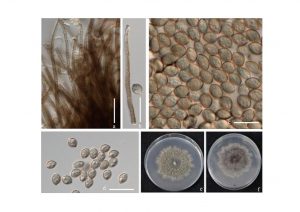Chaetomium globosum Kunze, in Kunze & Schmidt, Mykologische Hefte (Leipzig) 1: 16 (1817)
Index Fungorum number: IF 172545; Facesoffungi number: FoF 02196
Saprotrophic on a dead flower of Rosa sp. Sexual morph: Ascomata 160–300 × 130–220 μm (x̅ = 243 × 178 μm), superficial, globose, ellipsoid, ovate or obovate, greenish olivaceous or slightly dark olivaceous buff to grey in reflected light owing to ascomatal hairs, ostiolate. Ascomatal wall brown, composed of hypha-like or amorphous cells, textura intricata in surface view. Terminal hairs abundant, finely verrucose, brown, tapering and fading towards the tips, 3–5 μm diam. near the base, flexuous, undulate to loosely coiled with erect or flexuous lower part, usually unbranched. Lateral hairs brown, flexuous, fading and tapering towards the apices. Asci 28–40 × 10–15 μm (x̅ = 34 × 12 μm), biseriate, 8-spored, fasciculate, fusiform or clavate at spore-bearing part, with evanescent, 18–25 μm long stalks. Ascospores 8–11 × 6–7 μm (x̅ = 9 × 6 μm), olivaceous brown when mature, limoniform, usually biapiculate, bilaterally flattened, with an apical germ pore. Asexual morph: see Maharachchikumbura et al. (2016) for description.
Culture characteristics – Colonies on PDA reaching 50 mm in 7 days at 25 °C, brown or orange or white, woolly, even margin, reverse buff-coloured to brown, aerial mycelium cottony or felty, with funiculose setae and hyphae. Mycelium abundant, intramatrical and aerial, composed of hyaline or dark brown, septate, hyphae.
Material examined – Thailand, Chiang Rai, on dead flower of Rosa sp., 15 May 2018, Ruvishika S. Jaywardena RKB1 (MFLU 18-1833, new host record); living culture, MFLUCC 18-1156.
GenBank Accession numbers – ITS: MN788674, LSU: MN788679
Known distribution (based on molecular data) – Canada, Thailand (Esmaeili Taheri et al. 2017, Tibpromma et al. 2018)
Known hosts (based on molecular data) – Pandadus sp., Pisum sativum, Vitis sp., (Esmaeili Taheri et al. 2017, Jayawardena et al. 2018, Tibpromma et al. 2018), Rosa sp. (this study)
Notes – Chaetomium is a cosmopolitan genus with more than 150 species (Zhang et al. 2012). Chaetomium globosum is widely known for its biological control properties (Wang et al. 2012). This study provides the first report of C. globosum as a saprotroph associated with Rosa sp. in Thailand.

Fig. Chaetomium globosum (MFLU 18-1833, a new host record). a–b Terminal ascomatal hairs. c–d Conidia. e Upper view of 7 days old culture on PDA. f Reverse view of 7 days old culture on PDA. Scale bars: a–b=50 μm, c–d=10 μm.
